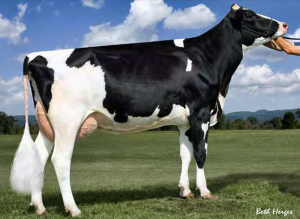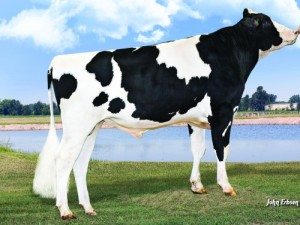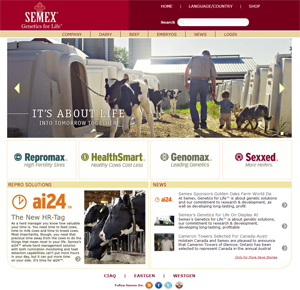While many would think that all farmer-owned cooperatives would have the same challenges and the same mandates, there could no greater contrast than the approaches taken by Select Sires and Semex. Select Sires is a federation of nine farmer-owned-and-controlled cooperative and Semex is a partnership of three breeder owned cooperatives. So structurally they are quite similar with perhaps some significant differences in mandates. However these two artificial insemination companies are headed in very different directions when it comes to approaches to communications and product development.
The Art of Sire Sampling

GLEN-TOCTIN BOLT LUCILLE VG-87
one of the dams selected for the ART program and dam of S-S-I DOMAIN LITHIUM
There no question that how an AI company defines its genetic mission, contracts young sires and proves bulls will greatly affect the profitability of the company. In 2009, the Select Sires board saw the writing on the wall with genomics, the new tool on the scene. The Board directed management to find new and better ways of procuring additional high-ranking, uniquely bred genetics in the most cost effect manner possible. This lead to the development of Aggressive Reproductive Technologies (ARTTM), a program that involves the ownership of a small group of elite females (Read – Should A.I. Companies Own Females). The females were purchased with plans to purposely breed them to create new and unique genetics for Select Sires, a product that would help differentiate them in the marketplace.
While Select insist that “the bulls resulting from the ART program compliment, not replace, bull calves that we continue to purchase from seed-stock producers” explains Jeff Ziegler, Genomics Program Manager at Select Sires. Semex, on the other hand, have made it very clear that they have “no interest in owning females” and decided that they would stick to what they know best, sire sampling, and let the breeders specialize in breeding the cattle. That may be a great brand position with their traditional seed-stock breeders, but if they cannot procure and prove they have the top genetics, it will mean nothing and prove to be a very costly mistake.
The Golden Rule – He Who Has The Bulls Has The Power

S-S-I DOMAIN LITHIUM
So how has this been working out? Seventeen of the top new 200 new release females for October are members of the ART program at Select Sires (Read – Top 200 New Release Females for October). In fact, this is a growing trend with 10/200 in September and 8/200 in July. There are also early genomic young sires making their mark, including MOUNTFIELD SSI DCY MOGUL (purchased as an embryo) who is already being used as a sire of sons. Two recent success stories from the female ownership side of ART are S-S-I BOOKEM MORGAN and S-S-I LITHIUM. Both are top 10 bulls on Holstein USA’s August active genomic young sires for GTPI at +2495 and +2470,respectively.
However, Select Sires ability to perform at an A+ level does not just come from the ART program. In recent August 2012 sire summary, Select Sires leads the industry with 36 sires on Holstein USA’s Top 100 Total Performance Index™ (TPI™) list with at least 97 percent reliability for milk and type. In addition, Select Sires is home to 10 sires over +3.00 for PTAT including the new #1 Type sire, MAPLE-DOWNS-I G W ATWOOD EX-90. They own the No. 1 TPI sire above 97% reliability for milk and type, Ensenada Taboo Planet EX-90-GM. The future is also looking bright with 24 of the top 50 GTPI active genomic young sires coming from the Select Sires Super SamplerTM lineup.
So how has Semex policy of partnering with top breeders instead of owning females being working for them? According to our analysis of the August 2012 New Release sires in Canada, a few of Semex’s partner herds have not been delivering the product. Two key Semex partner herds Stanton’s and Claynook saw nine sires proven with an average drop of 418 LPI points when compared to the GPA LPI’s. Those same two herds have seen an average drop of 635 points on over 40 bulls since the introduction of genomics back in August 2009 (Read – The Hot House Effect on Sire Sampling).
In fact, Select Sires owns the #1 LPI sire, Ensenada Taboo Planet EX-90-GM. Even in the market where Semex dominates in the number of young sires sampled it only have five out of the top 10 GPA LPI young sires from the August 2012 release. Remember they sample over 70% of the sires in Canada. and they only has three of the top 30 GPA TPI sires. By comparison GenerVations, which has been very active in the ownership of females, has four of the top 30 GPA LPI sires and they sample a small fraction of the sires that Semex does.
No Longer a Dictatorship –It Is Now A Two Way Conversation

Yet, as the world becomes more social, information, access to it and the ways the product will generate more customer profit as driving forces in today’s dairy cattle breeding world. It is no longer about control it is about accurate and new information. It’s about open two-way discussion. No longer can you dictate what people are to think, but rather you need to engage them in open honest conversations.
In the Bullvine’s recent articles about 7 Sires to Use in Order to Breed the Next World Dairy Expo Champion, The Top 12 Holstein Genomic Young Sires To Use for Maximum Genetic Gain and The Sensational 6 Top 6 North American Genomic Holsteins We Would Invest In, Select Sires not only allowed us to share it with their readers they actually posted it themselves on Facebook and Tweeted it as well. Semex either deleted our posts or did not even respond. It’s no wonder that Select Sires has the larger social following. Gone are the days when the one who pays the most control’s the media, as is evident by us here at the Bullvine.
The Bullvine Bottom Line
The marketing place is evolving, those companies that evolve and adjust will survive and thrive, those that don’t will fizzle out. I am not saying that Semex needs to run out and buy females, nor am I a saying that Select Sires is doing everything correctly. However, there are some significant differences in how these two companies procure and market their genetic products. These differences are leading the two companies in very different directions.


















True to form, Select Sires shared the link to this article and Semex erased it.
Andrew,
Dont you think you are being a little harsh on Semex???? As a breeder I can appreciate that they are not trying to delete the breeders from the equation.
On the other hand, I find it hard to see why breeders would be supportive of a business model where Select seems to be putting a wad of $$$ in their pockets on semen sold to the breeder, all the while trying to do away with us.
Thanks for your comments Adam,
However, how many breeders are they really work with as seed-stock
providers? Very few, yet there #1 obligation to members is to return
maximum profit. I understand the comment about a wad of $$$ in their own
pockets. Ultimately, since the members own them the cash does make it
back. My biggest challenge when it comes to all co-operatives is there
structure able to compete in today’s day and age. Just like many who say
unions have served their purpose, I wonder if co-operatives have served theirs
and are no longer efficient in today’s marketplace.
Andrew
Actually none at all. More just wanted people to look at the bigger picture as well as think of things in a more business like fashion.